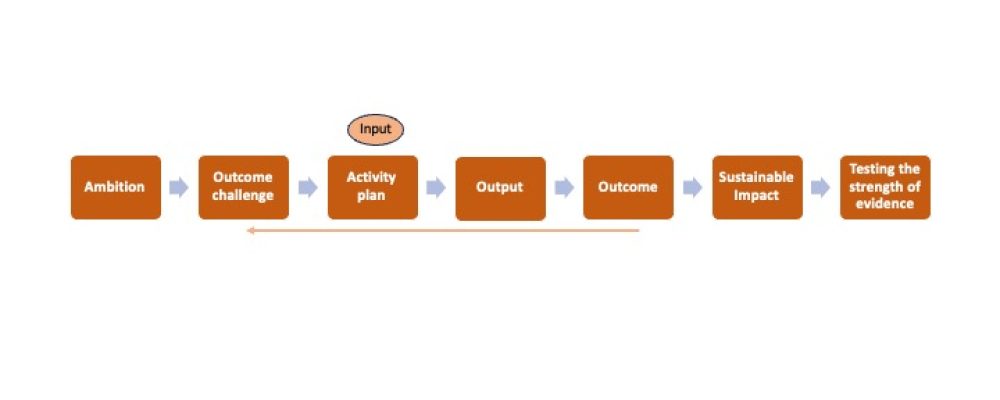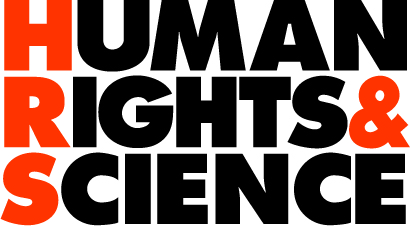Strategy for change (SfC)
We target sustainable operations and sustainable finances for:
i) The scaling of, and profit for, enterprises offering social good.
ii) Institutions and communities that are aid dependent and aim to become self-sustained instead.
In order to reach our goals it must be clear which components of a programme that are important for achieving an expected outcome and an expected sustainable impact. We use a management strategy addressing;
- Why the status quo would change and
- Who would bring the desired evolution.
The HR&S Management Strategy for Change (SfC) offers an opportunity to reflect over whether an expected sustainable impact is likely to happen as a result of the programme. The SfC defines the necessary conditions required to bring about impact. The SfC also points out which conditions that are sufficient.
The Strategy for Change describes the connections between Impact, Outcome, Output, Milestones, and Input, together with, Outcome challenges, Progress markers, Activities, the Strength of Evidence and Baseline, as well as Stakeholder analysis, Motivation, and Power of influence; all parameters compiled per Ambition. Progress is measured through the measurable entities Output and Outcome. Equally important are Lessons Learned and Informed Decisions.
Please note that the SfC is a narrative of the more ambitious HR&S tool, the “Real-time Outcome Planning & Evaluation” (ROPE).
Word the hypothesis
The hypothesis is a narrative of the Strategy for Change, it is a causal chain, linking cause A and the expected impact B while articulating the steps between the cause and the expected impact.
SfC Design & implementation
1. Identify exactly what we want to achieve (Ambition) and
2. identify measurable indicators of progress so that we can measure if we are proceeding in the right direction (Progress Markers).
3. Identify the challenges we have to reach our Ambitions (Outcome Challenges).
4. Agree on joint activities to address the challenge (Activities) and
5. on who is doing what exactly and when (Milestones).
6. Measure if milestones were met (Output).
SfC Impact & Impact measurement
- Measure actions taken by our target partners as a result of the Activities (Outcome) benefiting from the Progress Markers.
- Measure if outcomes that have become sustainable over time and do not require any more backup from the programme (Sustainable Impact).
- Compile the risks that may lead to sustainable impact failures (Impact Challenges) and take actions to mitigate those.
- Measure any impact that has occurred as a consequence of the programme but that was not directly targeted by the Progress Markers (Additional Impact). Additional impact can be positive or negative.
- Measure if the programme has had desired positive consequences years after we have closed the programme (Possible impact).
- Outcome and sustainable impact are measured using the HR&S tool Testing the Strength of Evidence (TestE). We benefit from scientific methods to measure the strength of the evidence for our claimed outcome and impact. The baseline describes the situation before starting the programme and constitutes the control against which the programme achievements are evaluated.

Explaining the value proposition of SfC with a parallel
If you got the information that ten children did go to school but they did not manage the exams, then you may want to know who these ten children were and what their challenges were. Was it lack of school-books, school uniforms, school lunches, sanitary pads, were they not able to do their home work…?
You may want to address those challenges. Maybe they need electricity and a lamp so the girls can attend homework after finishing they days household work…

Seven Steps
Terminology & definitions by HR&S
The 2023 update
- Ambition are expressed by the local stakeholders and answers to the question “What do you want to do and how do you want to do it?”.
The context is reviewed to answer to the question “How do you manage right now?”. - Outcome Challenges are the challenges hindering the local stakeholder from reaching her/his ambitions, and the answers to the questions “Why did you not reach your ambition already?”.
Context reviews are made to decide whether the proposal is i) justified, and ii) suitable for HR&S, thus the opportunity to achieve institutional capacity, financial viability and to deliver social good. - Activity plan are a compilation of actions to be taken in order to overcome the Outcome Challenges.
A Stakeholder committee is assigned with members that have enough intrinsic motivation, skills, and authority, to implement change and an enabling environment is ensured. Activities are broken down to Milestones; who is doing what, how and when.
The Input compiles available external resources required for the local stakeholder to reach the ambitions. - Output are Activities implemented by the Stakeholder committee and are scored real-time per Milestone. Low scoring calls for a review of if the environment is enabling. The Stakeholder Committee is in control of the Output.
- Outcome are actions taken by the local stakeholder as a result of the Activities. The Outcome is assessed real-time by quantitatively scoring Progress markers (PM), and low scores calls for Outcome Challenge review.
The Stakeholder Committee is not in control of the Outcome. - Sustainable impact is empowered by designing Standard operational procedures (SOP) from high scoring Outcome, targeting institutional capacity, financial viability and product/services requested for.
- The strength of evidence for sustainable impact (TestE) is tested real-time with scientific methods and is measured against the Ambition and the SOPs. Data is collected and assessed with field surveys and macro reviews addressing base-line, control, randomization, statistical assessment and contribution tracing. Lessons are learned, informed decisions taken and results reported.

To score high on ROPE Milestones is efficiency –
to do the things right,
to score high on ROPE Progress markers is effectiveness –
to do the right things.
Progress Markers
Scoring the Progress markers. The operation builds on a sequence of monitoring and evaluation events, for with dates, participants and results are recorded.
a. The monitoring starts at the same time as the design of the program. The first task is to identify the baseline of the program; the presentation of the situation prior to the start of the program. Progress marker scoring valuea together with the related comments are compiled in a monitoring data sheet.
b. Scoring values
5 Excellent, or 90 – 100%
4 Good, or 70 – 90%
3 Adequate, or 30 – 70 %
2 Poor, or 10 – 30 %
1 Insufficient, or 0 – 10 %
c. Scoring based on percentage supersedes scoring based on words. Thus, when a progress marker can be assessed with a percentage, then this is what the scoring shall be based on.
Notes
- There are three levels of Progress markers, depending on how difficult these are to achieve, where level one is the easiest to achieve. These progress markers can be defined according to two approaches, namely – term duration and degree of realism. In the term duration approach, level 1 are immediate responses that will be expected during the initial phase of the programme, level 2 are medium-term responses that one would expect after some time, and level 3 are long-term responses that one might expect and possibly after some time. In the degree of realism approach, level 1 are brutally realistic items, level 2 are somewhat idealistic items, and level 3 are items that are close to being unrealistic (think big).
- There are two types of Baseline: the micro level presents the local situation while the macro level presents national, regional or international data.
- There are two types of Outcome Challenges: internal and external. Internal outcome challenges are something we can have an influence on through our activities. External outcome challenges are out of our control and something we will acknowledge and somehow manage.
- Stakeholder analysis is the process of the assessing a decision’s impact on relevant parties. The stakeholders are organised into a grid with different matrices according to their interest and their power. Power mapping provides a theoretical framework and a set of tools to tap the power needed to make things happen. Power mapping is helpful in coalition building; with whom should we develop a relationship. The HR&S Stakeholder analysis is fully transparent and thus closely related to what is often referred to as “Public relations”.
- Public relations (PR) is the practice of deliberately managing the release and spread of information between our programme and the public. We aim to convince an audience, inside and outside our usual sphere of influence, to promote our idea, purchase our product, support our position, or recognize our accomplishments. Social media can augment PR efforts and serve as an amplifier.
- We work with Programme management partners (PP) and Target partners (TP).
- Programme management partners are the paying customers.
- Target partners level one (TP1) are: scientific researchers, laboratory technicians, social entrepreneurs, development stakeholders.
The second layer TP2 are the customers and other beneficiaries to TP1 and the third (TP3) are customers to TP2.
